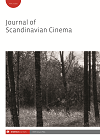- Home
- A-Z Publications
- Journal of Scandinavian Cinema
- Previous Issues
- Volume 5, Issue 1, 2015
Journal of Scandinavian Cinema - Volume 5, Issue 1, 2015
Volume 5, Issue 1, 2015
-
-
Heavy skies and a cold Soviet feel: Helsinki as a Cold War cinematic body double
More LessAbstractDuring the 1970s and 1980s, American and British films, and spy films in particular, situated in Moscow and Leningrad were regularly shot in the Finnish capital of Helsinki, since the film crews could not work inside the Soviet Union. This article addresses the creation of a ‘Soviet feel’ through the use of Helsinki locations in films such as Gorky Park (Apted, 1983) and Telefon (Siegel, 1977) in the geopolitical context of the Cold War and Finland’s location as both a hub for international espionage and something of a border zone between the eastern and western power blocs. This analysis is connected to a broader consideration of Cold War geography, cinematic cities as body doubles and the ‘agentiality’ of urban spaces in film.
-
-
-
Defining the friendly Other: A case study of the public reception of Finnish films in Sweden
More LessAbstractThis article discusses the relations between Swedish and Finnish film cultures adopting a historical cross-cultural reception framework. The cinema season 1937−1938 in Stockholm, when five Finnish films – an exceptional number – premiered, was a significant turning point for the import of Finnish films. The films aroused interest, and all of them were reviewed in the newspapers. The case illustrates how notions of both national cinema and national hierarchies are formed within transnational processes, which take place in networks encompassing different countries and cultures. Swedish journalists regarded Finnish cinema as backward compared to Swedish cinema, but as evolving: despite their primitiveness, Finnish films expressed authenticity and artistic ambition, even to a greater extent than Swedish films of the time. Through evaluations, comparisons and the construction of hierarchies, Swedish film journalists not only defined Finnish cinema but also presented ideas about Swedish and Nordic cinema.
-
-
-
Multiple adaptation processes: The case of Alexander Ahndoril’s The Director and its predecessors in feature film, television documentary and popular print media
More LessAbstractIt is well known that the novel by Alexander Ahndoril, Regissören/The Director (2006/2008), partially adapts Ingmar Bergman’s film Nattvardsgästerna/The Communicants (1963). It is less well known that the novel also adapts a television documentary about the shoot of The Communicants made in 1962 for Swedish public television by Vilgot Sjöman. In Ahndoril’s novel, then, the transfer moves from Bergman’s film and Sjöman’s documentary to the novel, in contrast to conventional adaptation practice, which moves in the opposite direction. Furthermore, besides moving images, other media have been adapted in Ahndoril’s novel, for example, feature stories in Swedish women’s magazines on Bergman and then-wife Käbi Laretei’s domestic life. Finally, Bergman’s journals have also been adapted, not from the original source text, however, but as represented in academic publications. In sum, Ahndoril’s novel is the result of a multiple adaptation process, involving not only moving images in the form of an art-film feature and a television documentary, but also still photography, popular print media and an academic publication. As such the novel also points towards a broader cultural adaptation process.
-
-
-
Ingmar Bergman, Swedish sexploitation and early Swedish porn
More LessAbstractThis article discusses intertextual relations between Ingmar Bergman films and four films from the Swedish history of late 1960s and 1970s sexploitation and pornography. Although Bergman played a significant role in the liberalization of film censorship in Sweden in the 1960s and was known for the beautiful actresses of his films, that he demonstrably inspired film-makers operating in what is usually regarded as the complete opposite of art cinema is not so widely known. In the films Jag – en oskuld/Inga (1968), Thriller – en grym film/Thriller – A Cruel Picture (1974), Justine och Juliette/Justine and Juliette (1975) and Fäbodjäntan/Come Blow the Horn (1978) there are several intertextual relations, both deliberate allusions and more implicit and unintended connections. These relations may have an impact on how we regard both the role of Bergman and the directors of sexually explicit films in the particular context of Sweden in the 1960s and 1970s.
-
-
-
Remarks on a failed film archival project
More LessAbstractThis brief article assesses an ongoing infrastructural research project focusing on filmarkivet.se, a website devoted to historical Swedish non-fiction film. As a collaboration between film researchers and film heritage institutions, the project has to date failed to overcome conflicting archival interests. Film scholars in general need open online archives and contextual resources, while some heritage institutions seek to give access solely to a curated filmic past. While cooperation between the heritage sector and scholars is regularly envisioned as being mutually beneficial, it also faces difficulties that need to be addressed and overcome.
-
Most Read This Month


